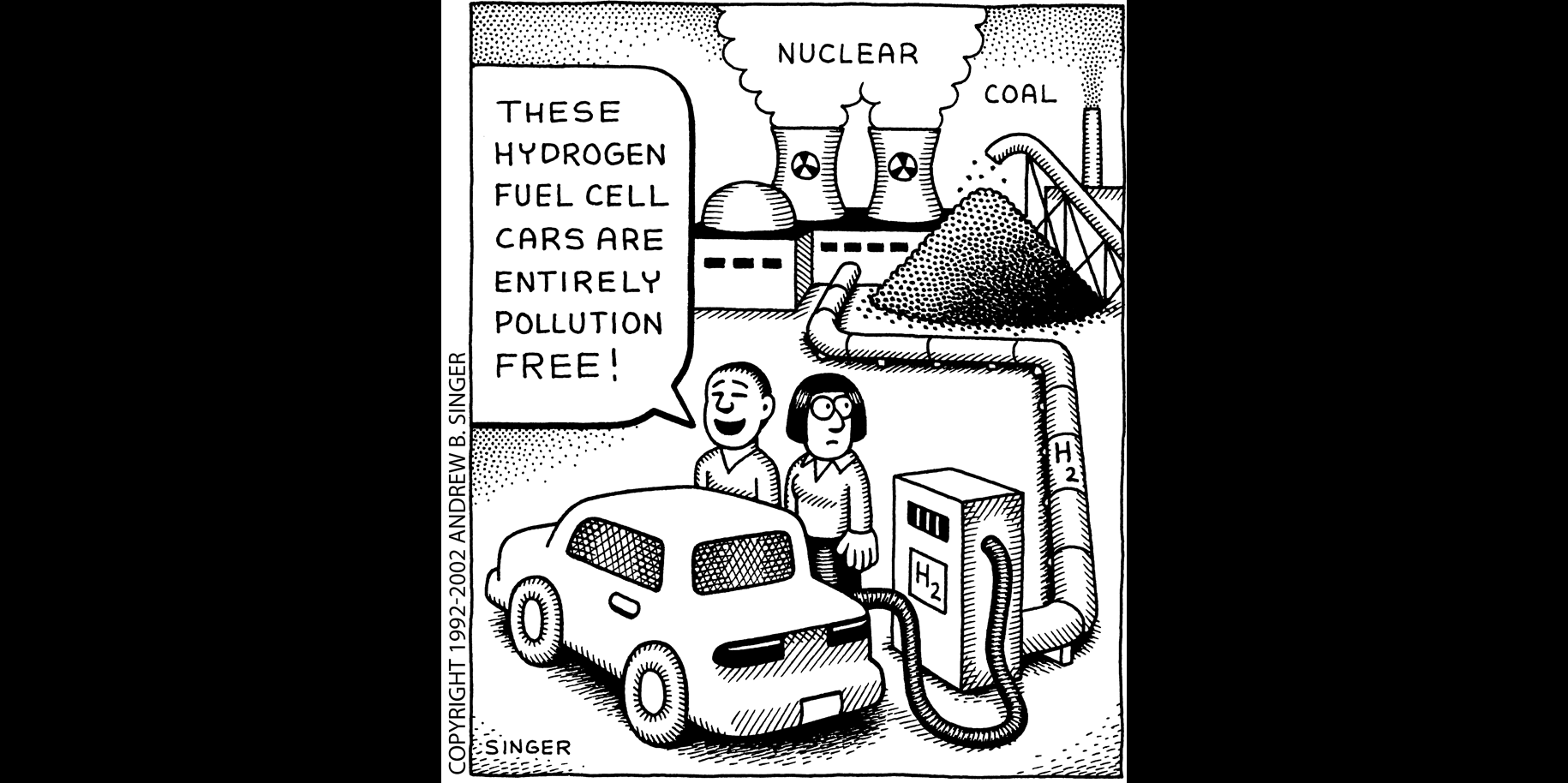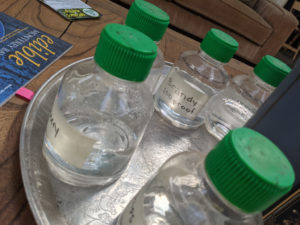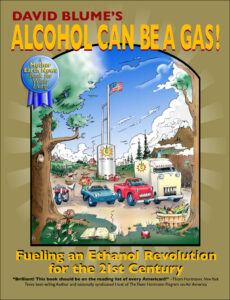
If you’ve heard bad things about ethanol (alcohol fuel), you may not realize they’re myths — promoted by those who gain from supporting fossil fuels.
THE VITUPERATIVE BILE AROUND ALCOHOL FUEL IS TOTALLY MISPLACED. WHEN USED WITH A VISION THAT INCORPORATES ORGANIC FARMING — A SHIFT AWAY FROM INDUSTRIAL FARMING, TOWARD SUSTAINABLE PRACTICES — ETHANOL IS AN EXCELLENT OPTION TO SOLVE OUR ENERGY PROBLEMS. ALL OF THEM, IF WE WISH.
MYTH #1: IT TAKES MORE ENERGY TO PRODUCE ETHANOL THAN YOU GET FROM IT!
Most ethanol research over the past 25 years has been on the topic of energy returned on energy invested (EROEI). Public discussion has been dominated by the American Petroleum Institute’s aggressive distribution of the work of Cornell professor David Pimentel and his numerous, deeply flawed studies. Pimentel stands virtually alone in portraying alcohol as having a negative EROEI — producing less energy than is used in its production.
In fact, it’s oil that has a negative EROEI. Because oil is both the raw material and the energy source for production of gasoline, it comes out to about 20% negative. That’s just common sense; some of the oil is itself used up in the process of refining and delivering it (from the Persian Gulf, a distance of 11,000 miles in tanker travel).
The most exhaustive study on ethanol’s EROEI, by Isaias de Carvalho Macedo, shows an alcohol energy return of more than eight units of output for every unit of input — and this study accounts for everything right down to smelting the ore to make the steel for tractors. But perhaps more important than EROEI is the energy return on fossil fuel input. Using this criterion, the energy returned from alcohol fuel per fossil energy input is much higher. In a system that supplies almost all of its energy from biomass, the ratio of return could be positive by hundreds to one.
MYTH #2: THERE ISN’T ENOUGH LAND TO GROW CROPS FOR BOTH FOOD AND FUEL!
According to the U.S. Department of Agriculture, the U.S. has 434,164,946 acres of “cropland” — land that is able to be worked in an industrial fashion (monoculture). This is the prime, level, and generally deep agricultural soil. In addition to cropland, the U.S. has 939,279,056 acres of “farmland.” This land is also good for agriculture, but it’s not as level and the soil not as deep. Additionally, there is a vast amount of acreage — swamps, arid or sloped land, even rivers, oceans, and ponds — that the USDA doesn’t count as cropland or farmland, but which is still suitable for growing specialized energy crops.
Of its nearly half a billion acres of prime cropland, the U.S. uses only 72.1 million acres for corn in an average year. The land used for corn takes up only 16.6% of our prime cropland, and only 7.45% of our total agricultural land. Even if, for alcohol production, we used only what the USDA considers prime flat cropland, we would still have to produce only 368.5 gallons of alcohol per acre to meet 100% of the demand for transportation fuel at today’s levels. Corn could easily produce this level — and a wide variety of standard crops yield up to triple this. Plus, of course, the potential alcohol production from cellulose could dwarf all other crops.
MYTH #3: ETHANOL’S AN ECOLOGICAL NIGHTMARE!
You’d be hard-pressed to find another route that so elegantly ties the solutions to the problems as does growing our own energy. Far from destroying the land and ecology, a permaculture ethanol solution will vastly improve soil fertility each year.
The real ecological nightmare is industrial agriculture. Switching to organic-style crop rotation will cut energy use on farms by a third or more: no more petroleum-based herbicides, pesticides, or chemical fertilizers. Fertilizer needs can be served either by applying the byproducts left over from the alcohol manufacturing process directly to the soil, or by first running the byproducts through animals as feed.
MYTH #4: IT’S FOOD VERSUS FUEL— WE SHOULD BE GROWING CROPS FOR STARVING MASSES, NOT CARS!
Humankind has barely begun to work on designing farming as a method of harvesting solar energy for multiple uses. Given the massive potential for polyculture yields, monoculture-study dismissals of ethanol production seem silly when viewed from economic, energetic, or ecological perspectives.
Because the U.S. grows a lot of it, corn has become the primary crop used in making ethanol here. This is supposedly controversial, since corn is identified as a staple food in poverty-stricken parts of the world. But 87% of the U.S. corn crop is fed to animals. In most years, the U.S. sends close to 20% of its corn to other countries. While it is assumed that these exports could feed most of the hungry in the world, the corn is actually sold to wealthy nations to fatten their livestock. Plus, virtually no impoverished nation will accept our corn, even when it is offered as charity, due to its being genetically modified and therefore unfit for human consumption.
Also, fermenting the corn to alcohol results in more meat than if you fed the corn directly to the cattle. We can actually increase the meat supply by first processing corn into alcohol, which only takes 28% of the starch, leaving all the protein and fat, creating a higher-quality animal feed than the original corn.
MYTH #5: BIG CORPORATIONS GET ALL THOSE ETHANOL SUBSIDIES, AND TAXPAYERS GET NOTHING IN RETURN!
Between 1968 and 2000, oil companies received subsidies of $149.6 billion, compared to ethanol’s paltry $116.6 million. The subsidies alcohol did receive have worked extremely well in bringing maturity to the industry. Farmer-owned cooperatives now produce the majority of alcohol fuel in the U.S. Farmer-owners pay themselves premium prices for their corn and then pay themselves a dividend on the alcohol profit.
The increased economic activity derived from alcohol fuel production has turned out to be crucial to the survival of noncorporate farmers, and the amounts of money they spend in their communities on goods and services and taxes for schools have been much higher in areas with an ethanol plant. Plus, between $3 and $6 in tax receipts are generated for every dollar of ethanol subsidy. The rate of return can be much higher in rural communities, where re-spending within the community produces a multiplier factor of up to 22 times for each alcohol fuel subsidy dollar.
MYTH #6: ETHANOL DOESN’T IMPROVE GLOBAL WARMING! IN FACT, IT POLLUTES THE AIR!
Alcohol fuel has been added to gasoline to reduce virtually every class of air pollution. Adding as little as 5–10% alcohol can reduce carbon monoxide from gasoline exhaust dramatically. When using pure alcohol, the reductions in all three of the major pollutants — carbon monoxide, nitrogen oxides, and hydrocarbons — are so great that, in many cases, the remaining emissions are unmeasurably small.
Reductions of more than 90% over gasoline emissions in all categories have been routinely documented for straight alcohol fuel. It is true that when certain chemicals are included in gasoline, addition of alcohol at 2–20% of the blend can cause a reaction that makes these chemicals more volatile and evaporative.
But it’s not the ethanol that’s the problem; it’s the gasoline. Alcohol carries none of the heavy metals and sulfuric acid that gasoline and diesel exhausts do. And straight ethanol’s evaporative emissions are dramatically lower than gasoline’s, no more toxic than what you’d find in the air of your local bar.
As for global warming, the production and use of alcohol neither reduces nor increases the atmosphere’s CO2. In a properly designed system, the amount of CO2 and water emitted during fermentation and from exhaust is precisely the amount of both chemicals that the next year’s crop of fuel plants needs to make the same amount of fuel once again. Alcohol fuel production actually lets us reduce carbon dioxide emissions, since the growing of plants ties up many times more carbon dioxide than is created in the production and use of the alcohol. Converting from a hydrocarbon to a carbohydrate economy could quickly reduce atmospheric carbon dioxide.
Download Busting the Ethanol Myths.





